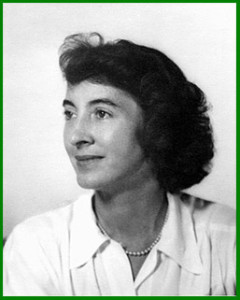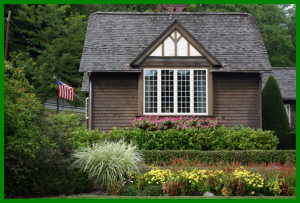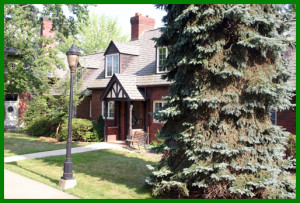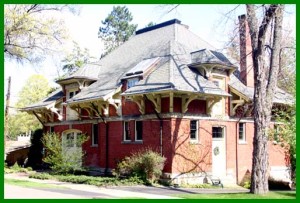History of The Crary Home

Clare J. Crary |

Gene Alden Walker Crary |
The fabulous estate of Clare and Gene Crary that is now the Crary Home resulted from good fortune in business being transferred back to the community in the form of an affordable home-like residence for men and women over the age of 55. A quote of Gene Crary from 1965 shows her husband’s vision for the Crary Home.
“His plan is to keep the present buildings (508 Liberty, The Studio, and the Carriage House) as unchanged as possible,-to create a real home, not an institution. It is an ideal location; near the hill, cool in the summer, protected in the winter and in no danger of being surrounded by other buildings. There is little traffic and yet so accessible to town. Most homes are so far out that guests feel isolated. Old folks like to be able to walk to town, browse in the shops, go to the movie. There are two points which Clare thinks very important: 1) to have separate buildings, 2) to retain the drive and turn around at the rear of the house (508 Liberty).”–Gene Crary 1965.
Clare’s vision was realized when the first Crary Home residents moved into the Cottage (209 6th Ave) which was built in 1976 after Clare’s death. In 1995 the Main House (508 Liberty) and the Studio were renovated and began accepting residents. An open house was held on May 21, 1995. In 2002, extensive renovations to the Brick House at 504 Liberty St. were completed and an open house was held November 2, 2002. The first residents moved in during January, 2003.
In this history of the Crarys you will see how Clare and Gene Crary not only established the Crary Home, but helped shape the Warren community that we know and love today.
The Crarys Come To Warren County
Warren County was growing rapidly during the late 1800’s . The discovery of oil, a bountiful expanse of timber, and the burgeoning industrial revolution set the stage for development of the wonderful community we enjoy today. Early industrialists gained great wealth from extraction of resources and manufacturing of products. Among those early entrepreneurs was a gentleman named Jerry Crary. He was born June 14, 1842 in Liberty, NY and came to Warren County in 1867 to join his older brother Horace H. Crary in Sheffield, PA. He was made a partner in one of his brother’s firms known as Horton, Crary, and Co., makers of sole leather. Several tanneries of the region were operated by the firm which also owned three sawmills. The Crarys were involved in oil through the firm of Crary, Sigel, and Co. drilling the first paying oil well in Warren County in 1881. In 1899, the firm of Crary, Horton, and Co. was earning 2.5 million dollars per year exporting leather tanned from hides mostly imported from South America.
Jerry Crary was married to Laura A. Dunham September 13, 1870 in Warren PA. They had four children while in Sheffield, PA. Three boys: Horace Allen, Miner Dunham, Clare J., and one daughter Marion A. Crary. The family moved to Warren in 1902 to the corner of Market Street and Sixth Avenue. Marion later moved to Brooklyn, NY, but the three sons remained in Warren and were very influential in development of the town. Miner Crary was Vice-President of Warren National Bank, and Clare was on the board of directors at that bank, later serving as Chairman of the Board for several years. Additionally, Clare was an officer in the Pennsylvania Furnace and Iron Company with his brother Horace. The children of Jerry Crary accumulated a great wealth from their personal business endeavors as well as through inheritance from their father’s business activities. From the beginning, the Crarys were active in the community.
Clare J. Crary
When people obtain great wealth in a town they often give generously to the community through philanthropic acts. Throughout his life Clare Crary was one of those people. Clare prepared for college at Worcester Academy in Massachusetts and graduated from Amherst College in 1901. He married Irene Horton of Brooklyn NY on April 19, 1906 and the couple had three sons: Calvert H., Douglas D., and Stephen T. Crary. Clare’s wife Irene passed away March 20, 1942. He built his home near his parents at 508 Liberty Street. After the death of his father, the family home on Market Street was razed, the lot remaining vacant for several years. Today the Crary Art Gallery stands in its place.
Following the death of Irene Crary, Clare married Gene Alden Walker, a New York City portrait painter and they resided at the 508 Liberty Street home. Together they contributed greatly to Warren society. In addition to his work with Warren National Bank and Pennsylvania Furnace and Iron Company, he was a world renowned photographer. He was one of the founders of the Pictorial Society of America which since has grown into the largest photographic society in the world with members from almost every country. His photographs have been shown in studios around the world, and he was named a fellow of the Royal Photographic Society of Great Britain, an associate of the Photographic Society of America, A member of the Oval Table Society, and an associate of the Pittsburgh Salon. He was a member of the Pictorial Photographers of America and the Camera Club of New York, NY. Clare was a founder of the Warren Community Chest which later became known as the United Fund. He founded the Northern Allegheny Conservation Association in 1961, a conservation organization that continues today. In 1967 he was named honorary president of the organization. He served as president of the Warren Library Association, Chairman of the Warren County Chapter of the American Red Cross, Treasurer of the Children’s Aid Society (now Family Services of Warren County, Inc.), Trustee of the First United Methodist Church where he was a member, Director of the YMCA, Director of the Warren State Hospital, and Director of the Struthers Library Building. Clare helped organize the Boy Scouts in Warren and served as scoutmaster for about 15 years and later was Commissioner of the Boy Scouts of America. Along with Holger Elmquist he organized the Warren Foundation (now the Community Foundation of Warren County) and within it established a scholarship fund and the Crary Medical Grant.
Clare Crary was more humble than most in the things he accomplished in his life, not seeking praise or glory. He was doing what he believed was best for a community he loved. Clare was most public in his love of photography and was known for that world-wide. He spent the last ten years of his life planning and building the Crary Home. Clare Crary passed away on November 27, 1975. His plans for the Crary Home were continued by his wife Gene and today the Crary Home is one of the region’s most attractive, affordable and comfortable retirement homes.
Gene Walker Crary
Gene Walker Crary was the wife of Clare J. Crary and was born January 31, 1898 in New Albany, Indiana the daughter of Herbert G. and Clara P. Walker. Gene was born Genevieve Alden Walker, shortening her name to Gene during all of her adult life. She was directly descended from John and Priscilla Alden, well-known passengers of the Mayflower and leaders in Plymouth, Massachusetts. Her father operated a Floral Shop in New Albany, Indiana that was originally established by her grandfather Francis Walker after he retired from the ministry in the Methodist Episcopal Church.
With a successful husband like Clare Crary it would have been easy for Gene to fade into the background. However, Gene accomplished a lot on her own, complementing the work of her husband. Gene was a well-known painter who studied under famed American painters Charles Hawthorne and Terry Farnsworth at the National Academy of Design in New York City. She painted under her maiden name Gene Alden Walker and maintained a studio at the National Arts Club in New York for 15 years. She exhibited her work widely and received many awards. Some of her work is represented in the permanent collection of the National Academy of Design, Montgomery Museum of Art, and a number of private collections. Gene was a member of the Grand Central Gallery of Art, Audubon Artists, National Arts Club, National Association of Women Artists, The Allied Artists and Pen and Brush Club. An award bearing her name, “The Gene Alden Walker Award” is given annually to aspiring female artists by the National Association of Women Artists.
Gene served as a member of the distributing committee of the Warren Foundation founded by her husband and was Director of the Northern Allegheny Conservation Association also founded by her husband. She established the Crary Art Gallery in memory of Clare J. Crary on the site of his parents’ home at 511 Market Street. She was a member of Trinity Memorial Episcopal Church, The Woman’s Club, Warren Philomel Club, Warren Art League, and The Garden Club. Gene was the Director and Vice President of the Watson Memorial Home, a role that inspired the Crarys to establish a home for the elderly on their own estate. Gene devoted much of her last years to completion of the Crary Home. She died January 14, 1988 at her 508 Liberty Street home. Today the Crary Home, the Crary Art Gallery, The Warren Foundation, and The Northern Allegheny Conservation Association are lasting legacies of the way the Crarys’ success in business was shared with the community throughout their lives.
The Buildings of the Crary Estate
The Main House at 508 Liberty Street

The English-type house was built by Clare J. Crary early in the twentieth century and was designed by the Buffalo, NY architect Edward A. Phillips who was becoming well known in this area. The half-timber dormers, overhanging eaves, and lattice paned windows are characteristic of Phillips’ work as is the fine paneled oak woodwork of the interiors. The decorations were done by the Buffalo, NY firm Prentice and Company.
The Studio

It is definitely known that Edward A. Phillips of Buffalo, NY designed The Studio building at 512 Liberty Street and it is a gem admired for its pattern of roof lines and angles with its rounded edges reminiscent of a Cotswold cottage. It was planned as a studio with a darkroom for Clare Crary’s photography. However, it has served many other purposes over the years. It was a game room and workshop for 15 years when Clare Crary was a scoutmaster. One part of the building was used as a potting shed for the Burnham greenhouse which was an integral part of the building’s design. When they decided to build an office in the space, the greenhouse was moved to the south side of the Carriage House on Sixth Avenue. The plantings around the studio and main house and the long flower border between were designed by the well-known landscape architects Harris and Hall of Buffalo, NY and Toronto, ON.
The Cottage

This building is located at 209 Sixth Avenue and was was constructed for use as a home for the elderly. The concept of the Crary Home was to provide a generous endowment to assure that it would always be self-sustaining. The building was designed by Robert A. Spillman of Bethlehem, PA. It is a gracious, warm, home-like residence far removed from an institutional setting. Elwood Landin was the contractor and every detail is perfection. Across from The Cottage on the upper side of Sixth Avenue is a small vegetable garden for the residents.
The Carriage House

The carriage house was part of the original estate owned by Jerry Crary and gives one an idea of what the Jerry Crary residence was like. It is brick with a slate roof and massive, overhanging eaves. In the basement are a laundry room, root cellar, three large storage rooms. On the street level a large door opens from Sixth Avenue into a large room for two carriages. Next to it, on the west side is another large room at the end of which there are two stalls for horses. The floors of both rooms are cement and the walls and ceilings are of finished wood. The second floor contains a four room apartment for the caretaker. Also on the second floor was a studio for Gene Walker Crary that included a sky light.
